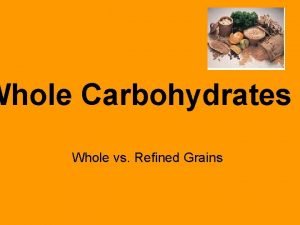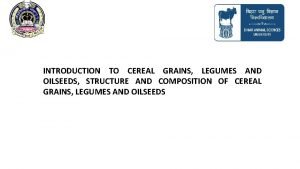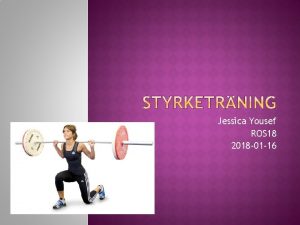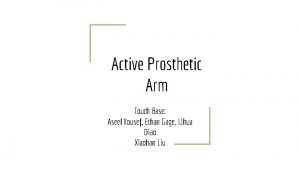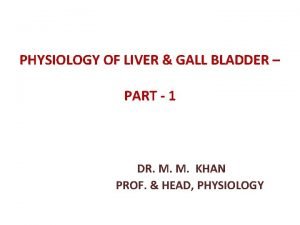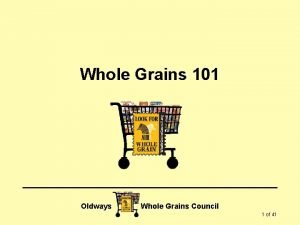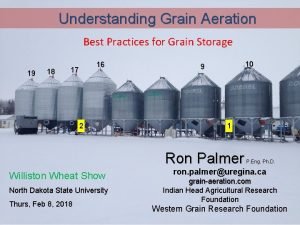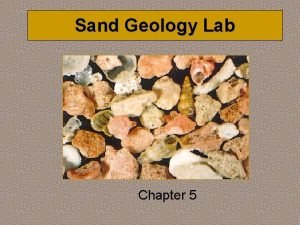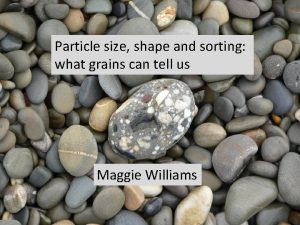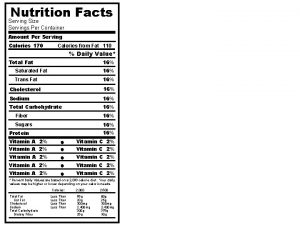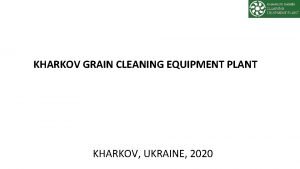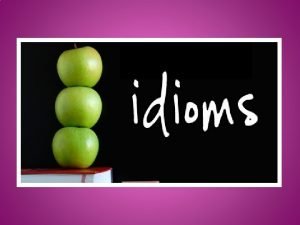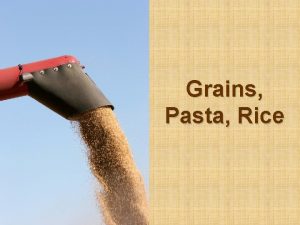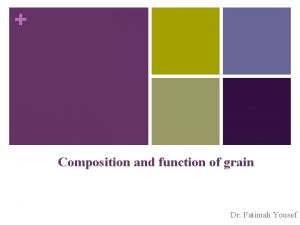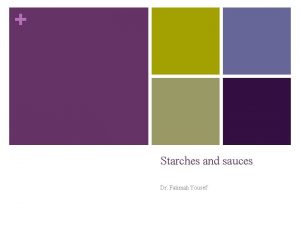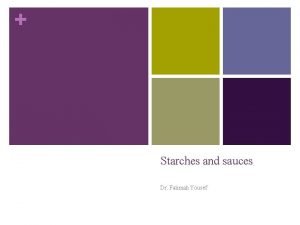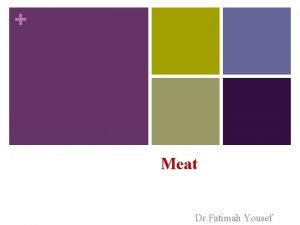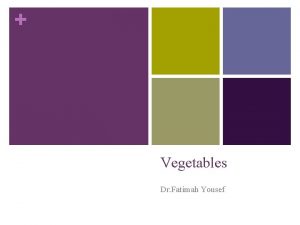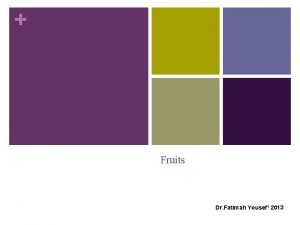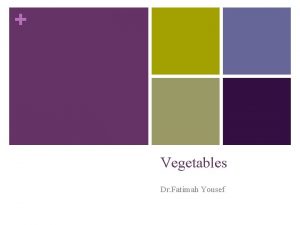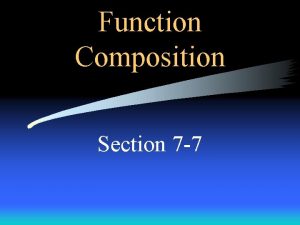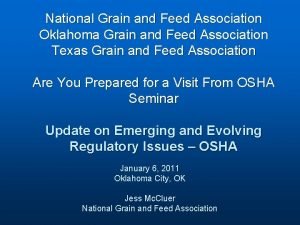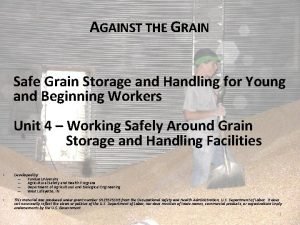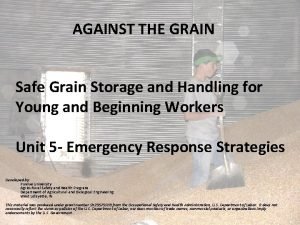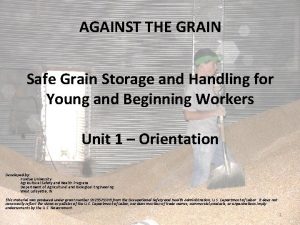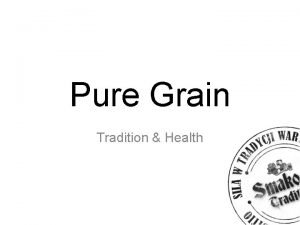Composition and function of grain Dr Fatimah Yousef





























- Slides: 29

+ Composition and function of grain Dr. Fatimah Yousef

+ What are Grains? Seeds of plants from the grass family.

+ What are Grains? n Every grain kernel is composed of 3 main parts: n Germ- Tiny embryo that will grow into a new plant. n Endosperm- Food supply for embryo. n Made up of proteins and starches. n Takes up most of the inner part of the grain. n Bran- Edible outer protective layer The bran and the germ are the most important nutrients parts because they have the most fiber, vitamins and minerals. n Husk: Rough outer covering protecting the grain, that is removed first. Dr. Fatimah Yousef 12013

Dr. Fatimah Yousef 12013

+ Nutrients in grains n Endosperm: It is high in complex carbohydrates and proteins, and small amount of vitamins and minerals. n Bran: It is rich in fiber, B- vitamins, some trace minerals. n Germ: It provides vitamins-B, vitamin E, iron, zinc, other trace minerals, some protein, and rich in fat. Dr. Fatimah Yousef 12013

+ Grain processing n Whole grain: Contains most of the original nutrients. n If bran and germ are removed, most of the fiber and nutrients are removed too. n. White flour, breakfast cereals undergo enrichment(some nutrients are added back) or Fortification(adding 10% or more of the Daily value of a specific nutrient back to the product, such as iron and folic acid). Dr. Fatimah Yousef 12013

+ Whole grain vs. refined grain Grain categories Whole grains Refined grains Dr. Fatimah Yousef 12013

Bran Whole grains contain the entire germ or “kernel” and bran. Endosperm Germ Dr. Fatimah Yousef 12013

Bran Refined grains contain only the endosperm Endosperm Germ Dr. Fatimah Yousef 12013

+ Types of cereal grain n Wheat n High gluten content enables bakers to make a variety of breads. n Referred to as “hard or “soft” according to protein content, and “red” or “white” according to the color of the kernels. Dr. Fatimah Yousef 12013

+ Types of cereal grain Rice n Brown rice: Whole grain form. n Only outer inedible hull is removed. n Fiber content is 3 times higher than white rice, but longer times of cooking are required n White rice: It has been milled and polished to removed the hush, bran and germ. n. All of the fiber and most of the B-vitamins and iron are eliminated, but some of these are replaced in enriched grains. Dr. Fatimah Yousef 12013

+Types of cereal grain Rice: n According to the length in relationship to the width of the grain , rice considered to be: n Short grains: n Almost round or oval in shape. n Moist and have less amylose and higher in amylopectin , which make them sticks together when cooked. n. Medium grains: n Plump, tender, moist. And have less amylose, which make them slightly stick together when cooked. n. Long grains: n Fluffy and contain more amylose, which make it stay separated when cooked. Dr. Fatimah Yousef 12013

+Types of cereal grain n Barley: n Very tough outer hull, difficult to remove without also removing the bran. n Hulled barley, available at health food stores, retains more of the whole-grain nutrients. n Has low gluten content making it bad choice for bread making but good for gluten intolerant diets. Dr. Fatimah Yousef 12013

+ Types of cereal grain Corn n Can be classified according to its kernel type: Dent, sweet, popcorn. n And classified by color: Yellow and white. Oats: n Slightly- sweet flavor makes oats a favorite for breakfast cereals n Unique among grains, oats almost never have their bran and germ removed in processing. Dr. Fatimah Yousef 12013

+ Uses of cereal grain Most of cereal grains produced are used for: n Flour, pasta, and breakfast cereal. n Flour: n Is the fine powder obtained from crushing the endosperm of the grain. n In whole grain flour, the bran and germ are also milled into the flour. n Any grain can be used to make flour. n Wheat flour provides the protein structure that facilities the rising of baked goods. n It plays an important role as a thickener. Dr. Fatimah Yousef 12013

+ Uses of cereal grain cont’d n Pasta n Comes in a variety of shapes. n Can buy enriched and whole wheat pastas. n Rich source of carbohydrate. n Although it is naturally low if fat calorie. n Some are flavored and colored with carrots, spinach, and tomatoes. n Noodles are made with eggs. n Can be made without the yolks. Dr. Fatimah Yousef 12013

+ Pastas Dr. Fatimah Yousef 12013

+ Pastas n Pasta, or “alimentary (nourishing) paste, ” is made by combining water with semolina flour and/or farina. n If eggs are added (at least 5. 5% egg by weight), the pasta product is referred to as “noodles. ” n Asian noodles may be made from: n Rice. n Mung bean. n Corn. n Potato. ……………. Flours.

+ Types of pastas n Pasta is formed by placing the freshly made pasta dough in a cylinder and forcing it through holes in small discs (dies). n High-protein pasta products that contain 20 -100% more protein than standard pasta. n Fresh pasta, found in the refrigerated section, has a higher moisture content, which gives it a softer consistency.

+ Preparation of cereal grains n Factors Influencing grain cooking: n Form of grain. n Presence of bran or hull. n p. H of the water. n Desired tenderness. …are factors that influence the amount of: n Water to be used n Heat intensity n Cooking time

+ Preparation of cereal grains n The desired results in prepared grains are most commonly achieved by moist-heat methods: n Boiling. n Simmering. n Baking in the presence of liquid.

+ Principles of cooking grains n Grains are cooked in water by different cooking methods and time. n Added B-vitamins are lost if rinsed before cooking. n You can microwave, but usually takes just as long as cooking on the stove. Dr. Fatimah Yousef 12013

+ Preparing rice and other grains n Rice is simmered: n Bring liquid to a boil. n Add rice and cover. n Reduce heat so rice simmers. n Do not stir unless necessary. n Rice should be moist and tender, but firm. n No liquid should be left in the pot. Dr. Fatimah Yousef 12013

+ Ready-to-eat and instant cereals n Dry breakfast cereals can fit into a healthy eating plan n Choose whole grain that is high in complex carbohydrates and fiber. n Some vitamins and minerals are added to cereals in the form of sprays, therefore dissolve in milk, so drink all of the milk. n Hot cereals are available in “instant” varieties n Sugar and other flavors often added Dr. Fatimah Yousef 12013

+ Preparing rice and other grains n Pasta is cooked in a large amount of boiling water. n Boiling helps circulate the pasta to cook evenly. n Cooked until al dente- firm to the bite. n Cooks in 5 -20 minutes n Drain in colander, do not rinse with water as it washes off nutrients n Stir in 1 tsp of oil to freeze pasta. Dr. Fatimah Yousef 12013


+ Storing grains and grain products n Store whole grain or whole grain products in the refrigerator if storing for a few weeks. n Contain oil so they can spoil at room temperature. n Refrigerate fresh pasta. n Store uncooked grains in a cool dry place. n Store breads at room temperature. n Store cooked grains in the refrigerator if using within a few days, freeze for later use. Dr. Fatimah Yousef 12013

+ Storage of cereal grains n Dry grains, freed of their bran and germ, are best kept in airtight wrappings or containers in a cool, dry area free of rodents, insects, and other pests. n Cooked whole grains can be frozen for future use if they are tightly wrapped or placed in airtight containers. Dr. Fatimah Yousef 12013

Storage of pasta n Dried pasta should be tightly wrapped and stored in a cool, dry place. n Fresh pasta should be kept in the refrigerator until the “use by” date. n Cooked pasta will keep for two to three days in the refrigerator.
 Whole grain and refined grain
Whole grain and refined grain Structure and composition of cereals
Structure and composition of cereals Fines fatimah
Fines fatimah Tarikh kewafatan rasulullah
Tarikh kewafatan rasulullah Siapa siti fatimah
Siapa siti fatimah Jessica yousef
Jessica yousef Aseel yousef
Aseel yousef Leena yousef
Leena yousef Sara yousef
Sara yousef Yousef javadi
Yousef javadi Sara yousef
Sara yousef Sara yousef
Sara yousef Cpit 110
Cpit 110 Operation and composition of function
Operation and composition of function Function composition and operations lesson 5-1
Function composition and operations lesson 5-1 Bile juice function
Bile juice function Perform function operations and composition
Perform function operations and composition Shower approach marketing
Shower approach marketing Grain track and trace solutions
Grain track and trace solutions Whole grain
Whole grain Grain bin aeration calculator
Grain bin aeration calculator Grain transportation report
Grain transportation report Grain size card
Grain size card Pollen polarity
Pollen polarity Sorting grain size phi
Sorting grain size phi Chips ahoy nutrition facts
Chips ahoy nutrition facts Ism grain cleaner
Ism grain cleaner Grain management software
Grain management software With a grain of salt idiom
With a grain of salt idiom Wheat germ is the whole grain minus the husk.
Wheat germ is the whole grain minus the husk.
